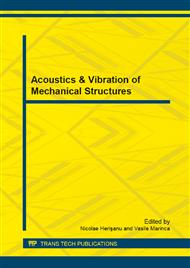[1]
P. Cawley, R.D. Adams, Location of defects in structures from measurements of natural frequencies, Journal of strain analysis, 14(2) (1979) 49-57.
DOI: 10.1243/03093247v142049
Google Scholar
[2]
L. Kannappan, S. Krishnakumar, Frequency measurement based damage detection methods applied to different cracks configuration, 48th AIAA/ASME/ASCE/AHS/ASC Structures, Structural Dynamics, and Materials Conference, 23-26 April 2007, Honolulu Hawaii, 1-12.
DOI: 10.2514/6.2007-2058
Google Scholar
[3]
P. F. Rizos, N. Aspragathos, A. D. Dimarogonas, Identification of crack location and magnitude in a cantilever beam from the vibration modes, Journal of Sound and Vibration, 138(3) (1990) 381-388.
DOI: 10.1016/0022-460x(90)90593-o
Google Scholar
[4]
R.Y. Liang, J. Hu, F.K. Choy, Detection of cracks in beam structures using measurements of natural frequencies, Journal of Franklin Institute, 328(4) (1991) 505.
DOI: 10.1016/0016-0032(91)90023-v
Google Scholar
[5]
W.M. Ostachowicz, M. Krawczuk, Analysis of the effect of cracks on the natural frequencies of a cantilever beam, Journal of Sound and Vibration, 150(2) (1991) 191-201.
DOI: 10.1016/0022-460x(91)90615-q
Google Scholar
[6]
M. Ashfari, D.J. Inman, Continuous crack modeling in piezoelectrically driven vibrations of an Euler-Bernoulli beam, Journal of Vibration and Control, 19(3) (2012) 341-355.
DOI: 10.1177/1077546312437803
Google Scholar
[7]
N. Khiem, T. Lien, A simplified method for natural frequency analysis of a multiple cracked beam, Journal of Sound and Vibration, 245(4) (2001) 737-751.
DOI: 10.1006/jsvi.2001.3585
Google Scholar
[8]
J. Fernandez-Saez, C. Navarro, Fundamental frequency of cracked beams in bending vibrations: an analytical approach, Journal of Sound and Vibration, 256(1) (2002) 17-31.
DOI: 10.1006/jsvi.2001.4197
Google Scholar
[9]
Q. Li, Vibratory characteristics of Timoshenko beams with arbitrary number of cracks, Journal of Engineering Mechanics, 129(11) (2003) 1355-1359.
DOI: 10.1061/(asce)0733-9399(2003)129:11(1355)
Google Scholar
[10]
K. Aydin, Vibratory characteristics of Euler-Bernoulli beams with an arbitrary number of cracks subjected to axial load, Journal of Vibration and Control, 14(4) (2008) 485.
DOI: 10.1177/1077546307080028
Google Scholar
[11]
G.R. Gillich, Z.I. Praisach, Damage patterns based method to locate discontinuities in beams, Conference on Health Monitoring of Structural and Biological Systems, San Diego, CA, March 11-14, 2013, Article Number: 8695-1100.
DOI: 10.1117/12.2009122
Google Scholar
[12]
G.R. Gillich, Z.I. Praisach, D.M. Onchis, About the effectiveness of damage detection methods based on vibration measurements, 3rd WSEAS International Conference on Engineering Mechanics, Structures, Engineering Geology/International Conference on Geography and Geology Corfu Island, Greece, Jul 22-24, 2010, 204-209.
Google Scholar
[13]
G.R. Gillich, Z.I. Praisach, Robust method to identify damages in beams based on frequency shift analysis, Conference on Health Monitoring of Structural and Biological Systems, San Diego, CA, March 12-15, 2012, Article Number: 83481D.
DOI: 10.1117/12.915158
Google Scholar
[14]
G.R. Gillich, Z.I. Praisach, I. Negru, Damages influence on dynamic behavior of composite structures reinforced with continuous fibers, Materiale Plastice, 49(3) (2012) 186-191.
Google Scholar
[15]
G.R. Gillich, Z.I. Praisach, D.E. Birdeanu, Considerations on natural frequency changes in damaged cantilever beams using FEM, 3rd WSEAS International Conference on Engineering Mechanics, Structures, Engineering Geology/International Conference on Geography and Geology, Corfu Island, Greece, Jul 22-24, 2010, 214-219.
Google Scholar
[16]
C. Bilello, Theoretical and experimental Investigation of Damaged Beams under Moving System, Ph.D. Thesis, Universita degli Studi di Palermo, Italy, (2001).
Google Scholar
[17]
T.J. Chondros, D.A. Dimarogonas, J. Yao, A continuous cracked beam vibration theory, Journal of Sound and Vibration, 215(1) (1998) 17-34.
DOI: 10.1006/jsvi.1998.1640
Google Scholar
[18]
P. Bratu, O. Vasile, Modal Analysis of the Viaducts Supported on the Elastomeric Insulators within the Bechtel Constructive Solution for the Transilvania Highway, Romanian Journal of Acoustics and Vibration, 9(2) 2012 77-82.
Google Scholar


